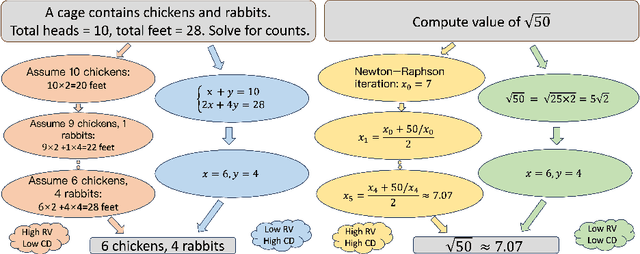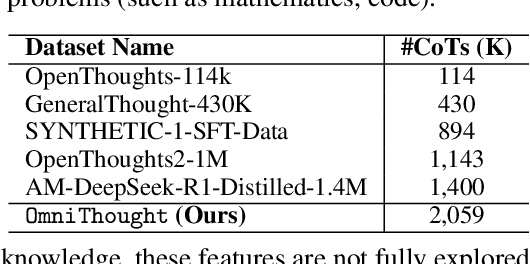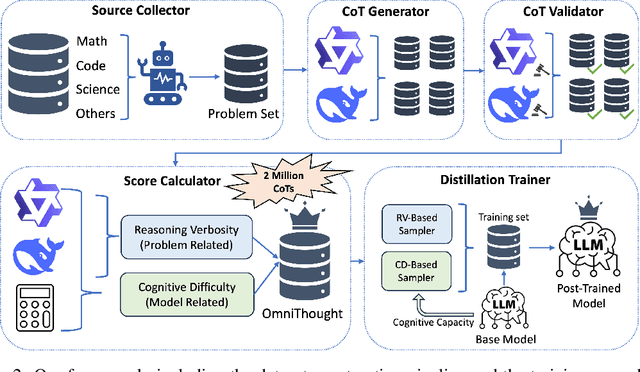Jun Huang
On Exact Editing of Flow-Based Diffusion Models
Dec 30, 2025Abstract:Recent methods in flow-based diffusion editing have enabled direct transformations between source and target image distribution without explicit inversion. However, the latent trajectories in these methods often exhibit accumulated velocity errors, leading to semantic inconsistency and loss of structural fidelity. We propose Conditioned Velocity Correction (CVC), a principled framework that reformulates flow-based editing as a distribution transformation problem driven by a known source prior. CVC rethinks the role of velocity in inter-distribution transformation by introducing a dual-perspective velocity conversion mechanism. This mechanism explicitly decomposes the latent evolution into two components: a structure-preserving branch that remains consistent with the source trajectory, and a semantically-guided branch that drives a controlled deviation toward the target distribution. The conditional velocity field exhibits an absolute velocity error relative to the true underlying distribution trajectory, which inherently introduces potential instability and trajectory drift in the latent space. To address this quantifiable deviation and maintain fidelity to the true flow, we apply a posterior-consistent update to the resulting conditional velocity field. This update is derived from Empirical Bayes Inference and Tweedie correction, which ensures a mathematically grounded error compensation over time. Our method yields stable and interpretable latent dynamics, achieving faithful reconstruction alongside smooth local semantic conversion. Comprehensive experiments demonstrate that CVC consistently achieves superior fidelity, better semantic alignment, and more reliable editing behavior across diverse tasks.
Enhancing Credit Risk Prediction: A Meta-Learning Framework Integrating Baseline Models, LASSO, and ECOC for Superior Accuracy
Sep 26, 2025Abstract:Effective credit risk management is fundamental to financial decision-making, necessitating robust models for default probability prediction and financial entity classification. Traditional machine learning approaches face significant challenges when confronted with high-dimensional data, limited interpretability, rare event detection, and multi-class imbalance problems in risk assessment. This research proposes a comprehensive meta-learning framework that synthesizes multiple complementary models: supervised learning algorithms, including XGBoost, Random Forest, Support Vector Machine, and Decision Tree; unsupervised methods such as K-Nearest Neighbors; deep learning architectures like Multilayer Perceptron; alongside LASSO regularization for feature selection and dimensionality reduction; and Error-Correcting Output Codes as a meta-classifier for handling imbalanced multi-class problems. We implement Permutation Feature Importance analysis for each prediction class across all constituent models to enhance model transparency. Our framework aims to optimize predictive performance while providing a more holistic approach to credit risk assessment. This research contributes to the development of more accurate and reliable computational models for strategic financial decision support by addressing three fundamental challenges in credit risk modeling. The empirical validation of our approach involves an analysis of the Corporate Credit Ratings dataset with credit ratings for 2,029 publicly listed US companies. Results demonstrate that our meta-learning framework significantly enhances the accuracy of financial entity classification regarding credit rating migrations (upgrades and downgrades) and default probability estimation.
RealMirror: A Comprehensive, Open-Source Vision-Language-Action Platform for Embodied AI
Sep 18, 2025



Abstract:The emerging field of Vision-Language-Action (VLA) for humanoid robots faces several fundamental challenges, including the high cost of data acquisition, the lack of a standardized benchmark, and the significant gap between simulation and the real world. To overcome these obstacles, we propose RealMirror, a comprehensive, open-source embodied AI VLA platform. RealMirror builds an efficient, low-cost data collection, model training, and inference system that enables end-to-end VLA research without requiring a real robot. To facilitate model evolution and fair comparison, we also introduce a dedicated VLA benchmark for humanoid robots, featuring multiple scenarios, extensive trajectories, and various VLA models. Furthermore, by integrating generative models and 3D Gaussian Splatting to reconstruct realistic environments and robot models, we successfully demonstrate zero-shot Sim2Real transfer, where models trained exclusively on simulation data can perform tasks on a real robot seamlessly, without any fine-tuning. In conclusion, with the unification of these critical components, RealMirror provides a robust framework that significantly accelerates the development of VLA models for humanoid robots. Project page: https://terminators2025.github.io/RealMirror.github.io
Enhancing Vehicular Platooning with Wireless Federated Learning: A Resource-Aware Control Framework
Jul 01, 2025Abstract:This paper aims to enhance the performance of Vehicular Platooning (VP) systems integrated with Wireless Federated Learning (WFL). In highly dynamic environments, vehicular platoons experience frequent communication changes and resource constraints, which significantly affect information exchange and learning model synchronization. To address these challenges, we first formulate WFL in VP as a joint optimization problem that simultaneously considers Age of Information (AoI) and Federated Learning Model Drift (FLMD) to ensure timely and accurate control. Through theoretical analysis, we examine the impact of FLMD on convergence performance and develop a two-stage Resource-Aware Control framework (RACE). The first stage employs a Lagrangian dual decomposition method for resource configuration, while the second stage implements a multi-agent deep reinforcement learning approach for vehicle selection. The approach integrates Multi-Head Self-Attention and Long Short-Term Memory networks to capture spatiotemporal correlations in communication states. Experimental results demonstrate that, compared to baseline methods, the proposed framework improves AoI optimization by up to 45%, accelerates learning convergence, and adapts more effectively to dynamic VP environments on the AI4MARS dataset.
Toward Safety-First Human-Like Decision Making for Autonomous Vehicles in Time-Varying Traffic Flow
Jun 17, 2025



Abstract:Despite the recent advancements in artificial intelligence technologies have shown great potential in improving transport efficiency and safety, autonomous vehicles(AVs) still face great challenge of driving in time-varying traffic flow, especially in dense and interactive situations. Meanwhile, human have free wills and usually do not make the same decisions even situate in the exactly same scenarios, leading to the data-driven methods suffer from poor migratability and high search cost problems, decreasing the efficiency and effectiveness of the behavior policy. In this research, we propose a safety-first human-like decision-making framework(SF-HLDM) for AVs to drive safely, comfortably, and social compatiblely in effiency. The framework integrates a hierarchical progressive framework, which combines a spatial-temporal attention (S-TA) mechanism for other road users' intention inference, a social compliance estimation module for behavior regulation, and a Deep Evolutionary Reinforcement Learning(DERL) model for expanding the search space efficiently and effectively to make avoidance of falling into the local optimal trap and reduce the risk of overfitting, thus make human-like decisions with interpretability and flexibility. The SF-HLDM framework enables autonomous driving AI agents dynamically adjusts decision parameters to maintain safety margins and adhering to contextually appropriate driving behaviors at the same time.
Zero-to-Hero: Zero-Shot Initialization Empowering Reference-Based Video Appearance Editing
May 29, 2025Abstract:Appearance editing according to user needs is a pivotal task in video editing. Existing text-guided methods often lead to ambiguities regarding user intentions and restrict fine-grained control over editing specific aspects of objects. To overcome these limitations, this paper introduces a novel approach named {Zero-to-Hero}, which focuses on reference-based video editing that disentangles the editing process into two distinct problems. It achieves this by first editing an anchor frame to satisfy user requirements as a reference image and then consistently propagating its appearance across other frames. We leverage correspondence within the original frames to guide the attention mechanism, which is more robust than previously proposed optical flow or temporal modules in memory-friendly video generative models, especially when dealing with objects exhibiting large motions. It offers a solid ZERO-shot initialization that ensures both accuracy and temporal consistency. However, intervention in the attention mechanism results in compounded imaging degradation with over-saturated colors and unknown blurring issues. Starting from Zero-Stage, our Hero-Stage Holistically learns a conditional generative model for vidEo RestOration. To accurately evaluate the consistency of the appearance, we construct a set of videos with multiple appearances using Blender, enabling a fine-grained and deterministic evaluation. Our method outperforms the best-performing baseline with a PSNR improvement of 2.6 dB. The project page is at https://github.com/Tonniia/Zero2Hero.
EasyDistill: A Comprehensive Toolkit for Effective Knowledge Distillation of Large Language Models
May 27, 2025Abstract:In this paper, we present EasyDistill, a comprehensive toolkit designed for effective black-box and white-box knowledge distillation (KD) of large language models (LLMs). Our framework offers versatile functionalities, including data synthesis, supervised fine-tuning, ranking optimization, and reinforcement learning techniques specifically tailored for KD scenarios. The toolkit accommodates KD functionalities for both System 1 (fast, intuitive) and System 2 (slow, analytical) models. With its modular design and user-friendly interface, EasyDistill empowers researchers and industry practitioners to seamlessly experiment with and implement state-of-the-art KD strategies for LLMs. In addition, EasyDistill provides a series of robust distilled models and KD-based industrial solutions developed by us, along with the corresponding open-sourced datasets, catering to a variety of use cases. Furthermore, we describe the seamless integration of EasyDistill into Alibaba Cloud's Platform for AI (PAI). Overall, the EasyDistill toolkit makes advanced KD techniques for LLMs more accessible and impactful within the NLP community.
Reasoning with OmniThought: A Large CoT Dataset with Verbosity and Cognitive Difficulty Annotations
May 16, 2025



Abstract:The emergence of large reasoning models (LRMs) has transformed Natural Language Processing by excelling in complex tasks such as mathematical problem-solving and code generation. These models leverage chain-of-thought (CoT) processes, enabling them to emulate human-like reasoning strategies. However, the advancement of LRMs is hindered by the lack of comprehensive CoT datasets. Current resources often fail to provide extensive reasoning problems with coherent CoT processes distilled from multiple teacher models and do not account for multifaceted properties describing the internal characteristics of CoTs. To address these challenges, we introduce OmniThought, a large-scale dataset featuring 2 million CoT processes generated and validated by two powerful LRMs as teacher models. Each CoT process in OmniThought is annotated with novel Reasoning Verbosity (RV) and Cognitive Difficulty (CD) scores, which describe the appropriateness of CoT verbosity and cognitive difficulty level for models to comprehend these reasoning processes. We further establish a self-reliant pipeline to curate this dataset. Extensive experiments using Qwen2.5 models of various sizes demonstrate the positive impact of our proposed scores on LRM training effectiveness. Based on the proposed OmniThought dataset, we further train and release a series of high-performing LRMs, specifically equipped with stronger reasoning abilities and optimal CoT output length and difficulty level. Our contributions significantly enhance the development and training of LRMs for solving complex tasks.
Deep Learning in Renewable Energy Forecasting: A Cross-Dataset Evaluation of Temporal and Spatial Models
May 06, 2025Abstract:Unpredictability of renewable energy sources coupled with the complexity of those methods used for various purposes in this area calls for the development of robust methods such as DL models within the renewable energy domain. Given the nonlinear relationships among variables in renewable energy datasets, DL models are preferred over traditional machine learning (ML) models because they can effectively capture and model complex interactions between variables. This research aims to identify the factors responsible for the accuracy of DL techniques, such as sampling, stationarity, linearity, and hyperparameter optimization for different algorithms. The proposed DL framework compares various methods and alternative training/test ratios. Seven ML methods, such as Long-Short Term Memory (LSTM), Stacked LSTM, Convolutional Neural Network (CNN), CNN-LSTM, Deep Neural Network (DNN), Multilayer Perceptron (MLP), and Encoder-Decoder (ED), were evaluated on two different datasets. The first dataset contains the weather and power generation data. It encompasses two distinct datasets, hourly energy demand data and hourly weather data in Spain, while the second dataset includes power output generated by the photovoltaic panels at 12 locations. This study deploys regularization approaches, including early stopping, neuron dropping, and L2 regularization, to reduce the overfitting problem associated with DL models. The LSTM and MLP models show superior performance. Their validation data exhibit exceptionally low root mean square error values.
CoordField: Coordination Field for Agentic UAV Task Allocation In Low-altitude Urban Scenarios
Apr 30, 2025



Abstract:With the increasing demand for heterogeneous Unmanned Aerial Vehicle (UAV) swarms to perform complex tasks in urban environments, system design now faces major challenges, including efficient semantic understanding, flexible task planning, and the ability to dynamically adjust coordination strategies in response to evolving environmental conditions and continuously changing task requirements. To address the limitations of existing approaches, this paper proposes coordination field agentic system for coordinating heterogeneous UAV swarms in complex urban scenarios. In this system, large language models (LLMs) is responsible for interpreting high-level human instructions and converting them into executable commands for the UAV swarms, such as patrol and target tracking. Subsequently, a Coordination field mechanism is proposed to guide UAV motion and task selection, enabling decentralized and adaptive allocation of emergent tasks. A total of 50 rounds of comparative testing were conducted across different models in a 2D simulation space to evaluate their performance. Experimental results demonstrate that the proposed system achieves superior performance in terms of task coverage, response time, and adaptability to dynamic changes.
 Add to Chrome
Add to Chrome Add to Firefox
Add to Firefox Add to Edge
Add to Edge